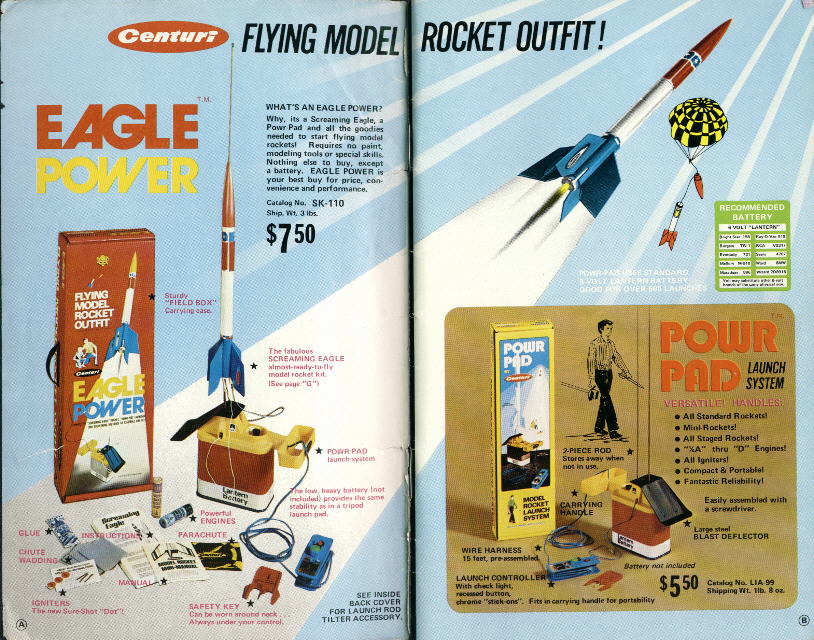clairm
Well-Known Member
- Joined
- Jun 1, 2012
- Messages
- 47
- Reaction score
- 0
This has been getting discussed tangentially on a couple different threads, so I decided to do an actual analysis over lunch.
Estes has digitized all of their catalogs and made them available on the web at https://www.estesrockets.com/customer-service/full-catalog/, so it is possible to compare prices over time. The Bureau of Labor Statistics (https://www.bls.gov/data/inflation_calculator.htm) has a handy inflation calculator that lets you adjust prices between any two years from 1913 to today.
I picked (somewhat randomly) six different items from Estes that I thought would be available over the decades and still be relevant today:
Alpha III - the original plastic-finned rocket, a first rocket for MANY
Big Bertha - classic with big balsa fins
Interceptor - sci-fi ground breaker, higher price and lower volume?
Starter Kit - Alpha (III) starter kit, rocket, motors, and launcher
A8-3 - small, mass produced, motor
D12-5 - biggest available motor for much of the time studied
a - The actual full retail price from the catalog (or web site)
s - What the price "should" be, based on the original 1970 (or 1980 for the Alpha III/Interceptor) price, adjusted for inflation.
Motor prices are based on the price of a (three) pack divided by the number of motors.
I started with 1970, because that is about when I got interested in the hobby. Looking at that catalog brought back a flood of great memories, including getting blue tubes of 3 motors for a dollar at the LHS! Anyway, the numbers:
The results:
Alpha III - costs twice what it should
Big Bertha - 35% too much
Interceptor - only 15% too much
Starter Kit - The cost of entry is lower than ever!
A8-3 - Almost twice what it should be
D12-5 - 50% more than inflation
Prices jumped by a lot during the 70s, no surprise there. The 2000s were also bad, with the price of an Alpha III almost doubling. The recent price changes don't look out of line with inflation at all. Anybody have Estes motor (or any other missing) prices from 2000? Looks like if you can use that 40% off coupon, almost everything is still available at the 1970 price!
Estes has digitized all of their catalogs and made them available on the web at https://www.estesrockets.com/customer-service/full-catalog/, so it is possible to compare prices over time. The Bureau of Labor Statistics (https://www.bls.gov/data/inflation_calculator.htm) has a handy inflation calculator that lets you adjust prices between any two years from 1913 to today.
I picked (somewhat randomly) six different items from Estes that I thought would be available over the decades and still be relevant today:
Alpha III - the original plastic-finned rocket, a first rocket for MANY
Big Bertha - classic with big balsa fins
Interceptor - sci-fi ground breaker, higher price and lower volume?
Starter Kit - Alpha (III) starter kit, rocket, motors, and launcher
A8-3 - small, mass produced, motor
D12-5 - biggest available motor for much of the time studied
a - The actual full retail price from the catalog (or web site)
s - What the price "should" be, based on the original 1970 (or 1980 for the Alpha III/Interceptor) price, adjusted for inflation.
Motor prices are based on the price of a (three) pack divided by the number of motors.
I started with 1970, because that is about when I got interested in the hobby. Looking at that catalog brought back a flood of great memories, including getting blue tubes of 3 motors for a dollar at the LHS! Anyway, the numbers:
Code:
Alpha III Big Bertha Interceptor Starter Kit A8-3 D12-5
1970a: 3.00 7.00 .30 .67
1980s: 6.37 14.87 .64 1.42
1980a: 3.75 5.75 9.00 15.95 .68 1.42 Wow, pretty close to inflation!
1990s: 5.95 10.11 23.58 1.01 2.26
1990a: 6.99 8.19 25.99 1.15 2.10 Plastic stuff jumped more than inflation, BB way cheaper, motors +/-
2000s: 7.84 31.07
2000a: 11.49 36.49 Dark days for Estes, high prices, little selection
2010s: 9.92 16.86 23.82 39.34 1.69 3.77
2010a: 18.29 22.99 27.99 32.49 3.00 5.10 Plastic stuff and motors are now double what they should be
2014s: 10.82 18.39 25.98 42.91 1.84 4.11
2014a: 19.99 24.99 29.95 32.79 3.43 6.00The results:
Alpha III - costs twice what it should
Big Bertha - 35% too much
Interceptor - only 15% too much
Starter Kit - The cost of entry is lower than ever!
A8-3 - Almost twice what it should be
D12-5 - 50% more than inflation
Prices jumped by a lot during the 70s, no surprise there. The 2000s were also bad, with the price of an Alpha III almost doubling. The recent price changes don't look out of line with inflation at all. Anybody have Estes motor (or any other missing) prices from 2000? Looks like if you can use that 40% off coupon, almost everything is still available at the 1970 price!




